Trigger Point Massage Tools
- Category
- Arms, Head & Neck, Hips, Legs, Torso
Trigger point massage tools help resolve problems with muscles that account for a very large proportion of the chronic myofascial pain people suffer all over the world. Muscles develop what people call knots, or myofascial trigger points, which can cause myofascial pain syndrome and dysfunction, which are small, local concentrations of electrical activity that can be detected by scientific instruments.
Myofascial Trigger Points TP display a typical pattern of localised tenderness and a tense band of shortened and weak fibres. Myofascial Trigger Points TP start with a muscle strain and becomes a site of sensitized nerves, increased metabolism and reduced blood flow. If left untreated it will become an area of scar tissue that does not stretch anymore and if there are enough of these trigger points, then the muscle will not function properly and cause ongoing problems. This often leads to myofascial pain in nearby joints and referred pain to other areas of the body. You feel the pain in one area, but the problem is in another area and so if you apply pain cream, heat, cold or massage to the area of myofascial pain it does not fix the pain because the problem is elsewhere. see the images to the right that show the referred pain areas.
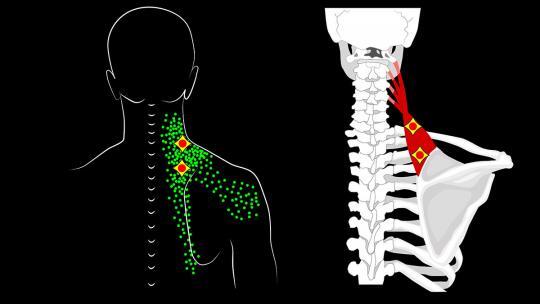
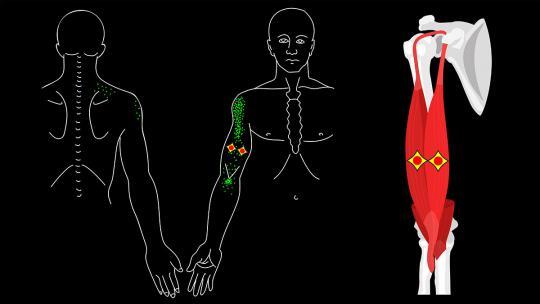
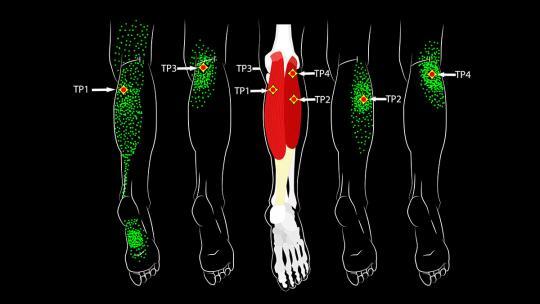
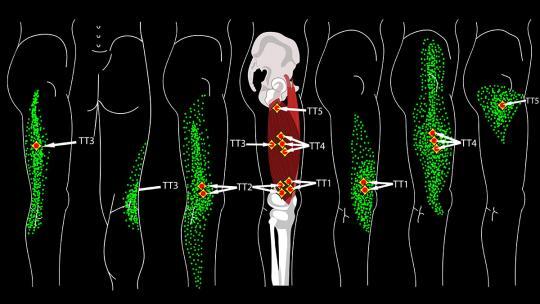
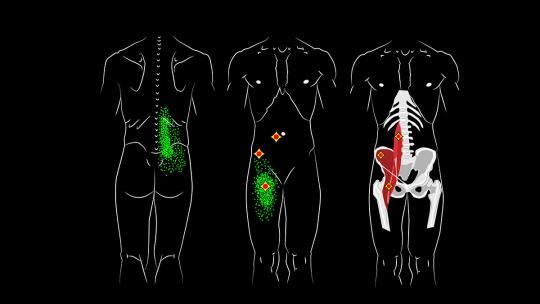
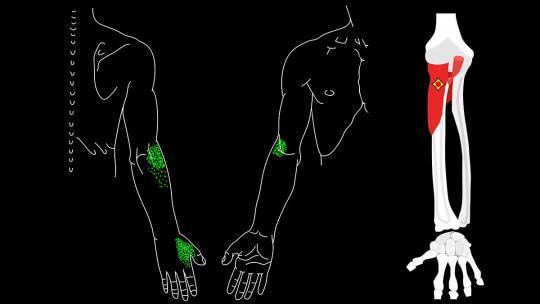
Trigger Point Therapy reduces myofascial pain at the location of the trigger point but also the referred pain away from the trigger point, increases movement, and allows the muscles to lengthen and become stronger. To treat Myofascial Trigger Points, enough pressure needs to be applied to the muscle to reach the TP which are often deep in the muscle and deactivate the electrical activity and unblock the blood flow again. Unfortunately foam rollers cannot produce the concentrated force required to treat and break up Trigger Points because of their large radii. That’s why the Mobilization Magic™ trigger point massage tool works so well with Myofascial Trigger Points.
Trigger Point Massage Tools
Pressure and Time make Diamonds and Happy Muscles
The reason this Trigger Point Massage Tool works so well is that it works on a material science concept called creep. Creep describes where a material has a concentrated force applied to it over time and that material yields to that force, an example of creep is when the gas spring of an office chair pushed through the 5 star base and drags on the floor. The gas spring crept through the base, just like the MMT tool creeps through your problem muscle like nothing else can and allows it to heal itself. https://en.wikipedia.org/wiki/Creep_(deformation)#Examples
In 1983, Janet Travell & David Simons, published a book on Myofascial Trigger Point treatment that revolutionised the treatment of myofascial pain and forms the basis of how they found that Trigger Points occur at the point where a nerve enters a muscle. Trigger Points result in muscles which have been stressed by accidents, sports, occupational stress, and overuse. Once a Trigger Point develops, it can remain for life unless properly treated. The Myofascial Trigger Point restricts range of motion of the muscles and decreases blood flow, reducing nutrients and oxygen to the muscle. This in turn causes a build-up of waste products including lactic acid, these chemicals stimulate pain nerve endings making them more sensitive, creating a vicious cycle that damages the nerve and muscle tissue and increases your pain and makes the muscle shorter and tighter.
These effects are not confined to the local muscle as tight contracted muscles can compress nerves and blood vessels causing sensations like throbbing, burning, numbness, pins & needles, coldness and swelling of upper and lower limbs.
Pressure applied to the Myofascial Trigger Point is called Ischemic Compression, Acupressure, Shiatzu and the Magic Elbow by some Chinese masseuses. Normal muscles do not contain Trigger Points, nor do they have taut bands of muscle fibers, are not tender to firm pressure, exhibit no local twitch responses and do not refer pain to other areas in response to firm pressure. Women are statistically more vulnerable to Trigger Points than men. There are two different types of stimuli that activate Trigger Points. Firstly there are direct stimuli like acute overload (unusual exercise), overwork fatigue (Shoulder/Neck and Lower Back muscles) chilling or gross trauma. Secondly there is indirect stimuli like other Trigger Points, visceral disease, arthritic joints and emotional stress.
The reason the Myofascial Trigger Point and the pain that is felt are often in different areas is not completely understood, it does have to do with the fact that nerves in muscles are part of a nerve distribution area like a tree which is serviced by a spinal segment in your spinal cord. The spinal cord segment is like a little computer and interprets the signal from Trigger Points before it sends it to the brain and in that process your brain interprets the pain being in a different location within the nerve distribution.
Using the Trigger Point Massage Tool
When using the trigger point therapy tool on a new spot only use it for a minute or so to see if it increases your myofascial pain for longer than a few minutes and reduce the pressure exerted by the roller or trigger point therapy tool by placing pillows or towels on top of or either side of these tools. If there is no sustained increase in pain after a few hours slowly increase the amount of time by a few minutes each time you use the tool. If you feel this spot is the centre of where you feel tightness and pain, you can spend 30 minutes or more on that spot until the tool melts deeply into the muscle and releases the trigger point and muscle fascia. Hot packs or even better hot baths greatly improve the effectiveness of these techniques as warm/ hot muscle stretch and give way more easily.
The beauty of this trigger point therapy tool is within your tolerance you can eventually lay on this tool for 30 minutes or more which penetrates deeply into the muscles in a gentle way. You will feel it slowly sink into the muscle over time as the tissues yield to the pressure. No other approach I know of enables you to put the right amount of pressure on these trigger points and very tight muscles for extended periods of time which is what they need to reverse the problems of many years.
You will get accustomed to this pressure quickly and so the way to progress this procedure is to use the trigger point massage tool in its tall option, which increases the pressure the tool exerts. Again, start this new use with only a few minutes to start with to ensure there is no increase in myofascial pain.
Always stretch the muscle before and after using the tool, notice if there is any increase in range of movement after using the trigger point massage tool ?
Trigger Point Therapy Roller Exercises
Foam Rollers are used all over the world to treat Trigger Points TPs and tight fascia, unfortunately foam rollers cannot produce the concentrated force required to treat and break up TPs because of their large diameter. Foam Rollers have a 150 mm diameter which produces a diffuse pressure that can increase pain by stirring up the nerves in the area and increase muscle spasms. Therapists use their elbow or thumb to treat TP’s and apply enough force to increase the pain initially but as the pressure is continued to be applied the pain melts away and the dysfunctional biology returns to normal.
Pain and tightness in muscles and connective tissue at the front, back and side of joints can cause pain and reduced range of movement of the joint.
Conventional stretching of these muscles has some effect on the pain and restricted range of the joint, but this can only help to a limited extent because stretching tends to stretch the parts of the muscle that are not constrained and stuck down by adhesions that develop around a tight painful muscle.
Getting Started with Trigger Point Therapy
Step 1
It is recommended that you take a hot bath or apply a hot pack to the affected area before you begin using the tool. Warm muscles stretch and give way more easily and this will greatly improve the tool’s effectiveness.
Step 2
Lay the muscle or joint onto the tool. Rate the pain you feel while using the tool from 1 to 10 (with 1 being the least pain and 10 being the greatest). Your pain when resting on the tool should not be more than 4-5.
Step 3
If your pain is greater than 5, place a towel or a cushion over the tool, or on either side of it, to reduce the amount of pressure, which should reduce the pain to a level of 5 or below.
Step 4
When you feel the position of the tool is in the correct central point where you feel tightness and pain, you can start off laying on the tool for a few minutes to make sure the tool does not increase your pain. If after a few hours rest everything is ok you can start increasing the time on the tool. Once you are comfortable with the tool you can spend 30 minutes or more resting on that same spot (watching TV or reading) until the tool melts deeply into the muscle or joint and releases that trigger point and muscle fascia
Step 5
The pain should begin to decrease within the first couple of minutes and continue to reduce as time goes on. If you notice no improvement within about five minutes, the muscle or joint may be too inflamed and may require the application of an ice pack. Try again later.

